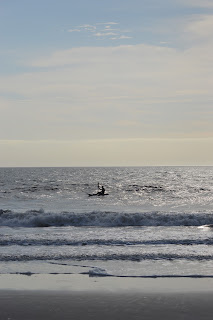 Meanwhile, additional entertainment was being provided by a toddler whose mother followed closely behind him as he ran amok through the obviously familiar space, picking up and moving around toys they apparently keep in the back for just such a...small child invasion. A few minutes later, a father entered with another little boy and exclaimed, "Look, buddy, Richard is here!" (I swear, it was like Cheers...for the preschool set!) It had become abundantly clear that I was the sole out-of-towner currently inhabiting the building...which was confirmed when I got up to leave, and the employee stopped what she was doing again to wish me a nice day...and the father apologetically remarked, "I hope we didn't ruin your quiet time!" Okay, okay...I admit that the local hospitality made up for the grammar faux pas--all is forgiven.
Meanwhile, additional entertainment was being provided by a toddler whose mother followed closely behind him as he ran amok through the obviously familiar space, picking up and moving around toys they apparently keep in the back for just such a...small child invasion. A few minutes later, a father entered with another little boy and exclaimed, "Look, buddy, Richard is here!" (I swear, it was like Cheers...for the preschool set!) It had become abundantly clear that I was the sole out-of-towner currently inhabiting the building...which was confirmed when I got up to leave, and the employee stopped what she was doing again to wish me a nice day...and the father apologetically remarked, "I hope we didn't ruin your quiet time!" Okay, okay...I admit that the local hospitality made up for the grammar faux pas--all is forgiven.Thus fortified, I made my final pilgrimage to the beach, to meander along the shore for a while and soak in the ocean vista. The weather was shaping up to be gorgeous again--a bit breezier than the previous day, but still delightfully warm and sunny. This boded well for my last planned activity: a history field trip to a Civil War battlefield I'd never even heard of, prior to looking up "Stuff to Do in Carolina Beach" online before my getaway. I couldn't believe this had somehow escaped my notice up to this point, so I was intrigued. (And also, of course, super-excited about the prospect of learning something new along the way...yaaaayyy! What? This isn't everyone's idea of a perfect weekend excursion? Huh...)
Besides, it was only 5 miles from the hotel where I'd spent the night, so I figured it was a low-risk venture. If it was lame, or boring, I'd just hit the road and head back home early. Fortunately, though, Fort Fisher turned out to be neither of those things, but rather a scenic and fascinating site complete with descriptive plaques detailing its importance in the War Between the States, beautifully preserved fortifications that helped you visualize how the conflict played out...and cannons. (I'm such a sucker for those things, I tell ya...no idea why...)
Here's the Cliffs Notes version: with fewer railroad lines in the South, waterways were absolutely vital to the Confederacy, for maintaining trade relationships and transporting supplies to where they were needed. Thus the Union carried out a prolonged campaign of blockading port cities, because every one they captured hurt the Confederacy's chances of winning the war. Wilmington, NC was the last port open in 1865, in part because of its unique topography--there were 2 avenues of entry on the Cape Fear River, allowing small, quick boats to more easily evade the Union ships that were stationed there to bottle up the city.

In fact, this worked for a while, as blockade-running crafts slipped by time and again. However, in January of 1865, a concentrated land and sea attack finally breached the fort, and it fell to the Union forces, effectively ending the Confederacy's ability to move trading goods and war materials by water routes. Not coincidentally, the war came to an end two months later with the South's surrender.
As I mentioned, all of this was news to me... and while it's no secret that I love this kind of gratuitous educational opportunity...in this particular case, it certainly didn't hurt that you could still catch glimpses of the sea while wandering around all the informational displays!
 Anyway, when I'd had my fill of "grown-up school" for the day, I hopped back in the Subaru for the return journey to Chapel Hill. While I felt content that I'd maximized my short time at the coast, I always find myself a bit...melancholy when it's time to leave the beach. So it was both amusing and...I don't know...eerily apropos?...that I spotted this sign on the way out of town: "shake sand off your shoes...not off your soul". Dude, I'm not even totally sure what that means, but I think I need a t-shirt, ASAP! For the time being, hasta luego a la playa!
Anyway, when I'd had my fill of "grown-up school" for the day, I hopped back in the Subaru for the return journey to Chapel Hill. While I felt content that I'd maximized my short time at the coast, I always find myself a bit...melancholy when it's time to leave the beach. So it was both amusing and...I don't know...eerily apropos?...that I spotted this sign on the way out of town: "shake sand off your shoes...not off your soul". Dude, I'm not even totally sure what that means, but I think I need a t-shirt, ASAP! For the time being, hasta luego a la playa!





































No comments:
Post a Comment